I got my Ace 250 Metal Detector two days ago and fired it up yesterday. Within 10 minutes I had me a find (see image); a brass pendant two inches deep and pretty much right under my hammock (this is an example of something). It’s not that it’s worth a lot but looking at it you know there’s a story here, and how it came to rest underground in the desert.
So I’m launched in my beneath-the-surface quest for stories and maybe even history. I’ll especially be looking for vertical erosion walls so I can scan, horizontally, the layers of time represented by the continual laying down of the surface grit. You don’t see other treasure hunters doing this (I also asked the detector-woman down the way), which is good news: Virgin territory!
There’s a dry wash with some nice erosion walls just behind my site, and today I’ll give it try. My goal is to find artifacts of historical worth. Or story-telling worth, insofar as there is a distinction. In a way, my finds could be relevant to some of the deeper issues we talk about here.
One example just popped into my head: Recall that I’ve wondered about the total lack of Civil War photographs that show real carnage, i.e., the many high body count images that should be a part of the historical record but are not.
Addendum: I viewed Ken Burns’s Civil War epic and could not find even one photographic image with more than about a score of after-battle corpses; most had no more than a half dozen. Given that at least three Yankee photogs were at the Battle of Gettysburg alone, and that tens of thousands were mowed down, how is that no one thought to capture an aftermath? How about, say, Picket’s Charge?
Seriously, how do you explain that?
This would not be much of an issue but for the high strangeness of matters like… well, here’s my list of possibly related phenomena:
UFOs
Paranormal Phenomena (which may be closely related to UFOs)
Star Visibility Anomalies
Historical Anomalies
The ‘Moon Numbers’ (Statistical evidence of a ‘higher power’)
Intelligent Design (I speak of bio-evolution and the ‘fine-tuning’ of the cosmos)
Simulation Theory (SH)
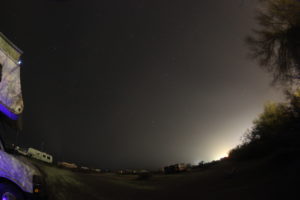
That bright sky lasted from about 4 AM to 7 AM, and I have no idea what caused it. Check out the video for more.
The Mandela Effect
I’ll surely be coming back to the list in future posts, but for this one my point is that we — many of us if not all of us — tend to spend our educational/research time staring at (and listening to) the device now in front of us. Yep, the Internet is… fuck… It’s our gateway to virtually all the knowledge mankind has gleaned, from the very beginning, at least that which can be communicated via words and visual images. That 99% of this ‘knowledge’ is incorrect, untrue, misleading, based on deceit, or irrelevant to any thinking mind is not the point. (Even the deceit incorporates truth, if you know how to read it.)
No, my point is that to really contribute to the true knowledge base, we have to get out of Netland, into the real world and… and dig, so to speak… and look at that world. See, it now occurs to me that with my new pastime, i.e., literally digging up the past, combined with my nightly sky-lapses, I’m doing my part in creating knowledge (in the ‘As above, so below’ sense), rather than re-interpreting it (which is what even valuable Net-research amounts to).
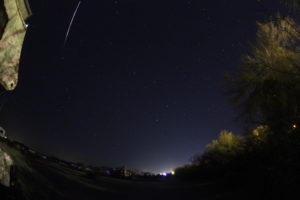
From last night, a ‘one-framer,’ meaning it only showed up in one (10 second) image. This is significant (more to come), as is the length of the artifact. Depending on distance, this baby was hauling ass; 2,000 mph is my estimate, as compared to the known speed of commercial aircrafts, which leave a much shorter trace.
If you’re thinking, ‘What kind of knowledge creation is digging holes and filming empty skies?’ then, well, we think differently. Or, rather: let’s wait and see what I dig up or make an image of.
Depending on your level of interest and time availability, I would ask you all to consider getting into this sort of thing. If the cost of a metal detector is daunting (under $300, plus a little shovel) and maybe you already have a camera, why not do your own sky-lapses? It’s easy, once you understand what photographs really are.
It’s also nice at night to be reading or watching a (hopefully) good story on my iPad or fast asleep or whatever, knowing that my two cameras are catching anything that might happen in the heavens, at least in the visual area of the electromagnetic spectrum.
I’ve gotten so serious about it that it does take a bit of time, post-production-wise. See, when you capture 10 or 12 hours of time, you have to view it to see what wild-ass stuff might have transpired, and you can’t hurry that too much. You’ll surely miss something.
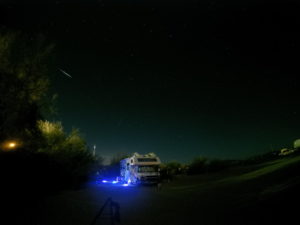
This is from February 2 is another ‘one-framer.’ I get a lot of these and will be analyzig what they might be in an upcoming post. (Click it!)
I get up in the morning, first thing I do is collect the cameras and plug the chips into the Mac. It then takes ten or so minutes to create a video from the 4,000 or so photographs. But you can’t just then watch the video as is; the night would go by in less than two minutes (depending on your time lapse interval), and you’d likely miss a ‘one-framer’, i.e., an interesting ‘artifact’ that only shows up on one discreet image. (Which means it represents, say, 10 seconds of real time, if that’s your exposure time/interval setting).
So you slow down the video and stare at an essentially unchanging photograph for twenty or so minutes. It’s simultaneously interesting as hell and boring as hell. Just as your eyelids are starting to droop, BAM!, something weird flashes and you’re asking yourself, ‘What could have caused that?’ Once you understand how photography works, and with a basic understanding of physics and optics, you rule out stuff until there are only one or two possibilities. It’s a classic example of ‘When you have eliminated the impossible, whatever remains, however improbable,
must be the truth.’ You get better at it as you exercise your thinking.
A good example of this is from two nights ago… actually, yesterday morning, between 4 and 7 AM. (Between the ‘treasure find’ and the sky-lapse, a great ‘as above, so below’ day.) Take a look at the video and see what you think caused that ‘sky-bright’ effect. I posted the video yesterday and already have some people on the case, including a former army grunt who helped narrow down the possibilities:
The treasure hunting likewise involves various subtleties. I’m already halfway to learning how to tell a pop top tab from a genuine relic, via the sound-frequency the Ace 250 makes when it’s over something. And there’s a bit of an art to digging/sifting too.
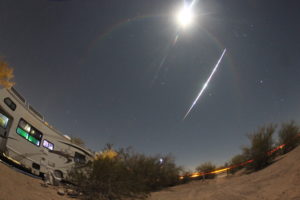
This was yesterday, Feb. 4th, 8:01 PM. This is no doubt a meteor. (A 10 second exposure but the burn could have taken less time; no way of telling. Click for a good look at the details.)
Okay, if anyone needs some sky-lapse or treasure hunting advice, put your questions in the comments.
Allan
And don’t forget about the Glossary post. I’ll be adding to it and refining it so give it an occasional look. (Thanks again to Joe Antos for his collaboration.)

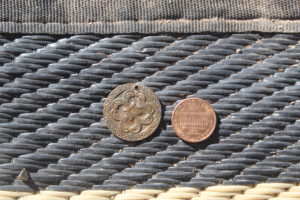
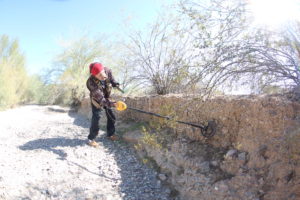

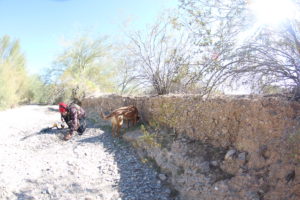
40 comments for “As above, So… (and so forth)”